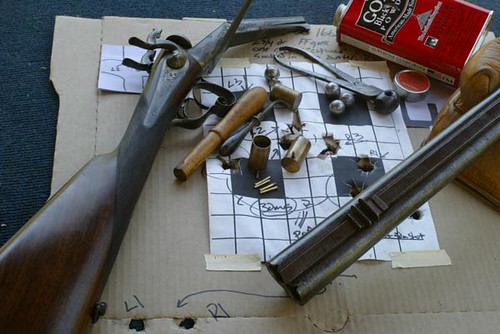| tinker |
| (.416 member) |
| 25/06/08 02:45 PM |

|
|
|
Xausa-
For fine guns, it's typically necessary to make a set of screwdrivers (turnscrews would be considered proper vernacular in high buck, high pinky finger company) for each gun, or to have a very broad selection of screwdrivers.
I have a lot of special screwdrivers, but I've been a machinist for most of my adult life.
This process assumes the screw slots have parallel walls.
Not all gun screw slots have parallel walls, so do what you can to determine this feature before you take this particular approach.
If the slots are vee shaped (wider at the mouth, narrower at the root) the general notion of this process can be used, with the obvious distinction that you're going to need to match the profile of the screw.
Start with a very good quality screwdriver.
Equally important is a good grinder motor with a true, round, flat faced wheel.
You'll want a diamond wheel dresser for the truing and flat-facing of the wheel.
This is one of those grinder operations where the tool rest is useful for the truing operation, but will likely get in your way for the screwdriver prep part of the operation.
Also, I don't have guards around the wheels on my grinder motors, and I can't suggest you do the same, you'd have to take that kind of risk on your own. I just find them distracting, and I always wear polycarbonate safety glasses when in my machine shop.
Once the grinding wheel is true and it's face is flat, I gently bring the width of the blade to nearly the width of the screw slot.
I then apply each of the faces of the blade to the wheel, so that the initial contact point is about 1/3rd the way back from the tip of the screwdriver. Do this in little passes, dipping in cool water between passes, alternating faces of the screwdriver tip until you have thinned it to the point where it's darn close to fitting the slot, but still a bit thick. You'll notice that you've also effectively 'hollow ground' the faces of the screwdriver. The tip will be a tad wider than the section where the wheel was initially touching off to the blade. It's also important to keep the faces of your screwdriver tip essentially paralell so that you're not ending up with a screwdriver tip which appears to be a wedge when viewed end-on.
At that point, re-flat the face of the wheel.
Then with the tool rest still in place from that last face-flatting exercise, adjust it so that the tip of the screwdriver meets the wheel square-on.
Take very light passes on the tip until it juuuust almost fits the slot in the screw.
Finish the last couple thousandths of an inch off the blade faces on a good hard bench stone.
Ideally you've just gotten the screwdriver to perfectly fit the slot and still have it set up where it's contacting the base of the slot, and not touching the outer edges or face of the screw.
Consider the possibility that the screw is for a countersunk instead of counterbored (conical shaped head and not cylindrical head), in this case the screwdriver will need to be a little narrower than the screw slot.
Also consider that this process will take more than one try to get the feel of the process.
With an elementary command of this process, you will never be in need for the right screwdriver again.
I offer this as a solution for the reason that for years I've seen 'precision screwdriver kits' where not a single screwdriver in the kit fit perfectly a screw on a fine gun anywhere near the kit, without some modification or complete re-work of one of the screwdrivers -- where the use of any of the drivers in the kit would have butchered the screws in the course of removing and replacing them if it weren't for a fair bit or re-work.
My two cents.
--Tinker